Some say that if art could be explained in words it would have no reason to exist. Whether we like it or not, I believe that an art work cannot be read without taking into account the evolution of the artist. A path which insists in the ongoing process of art history.
Speaking of Ng Sai Kit’s visual research we cannot but recognize that the definition of landscape, rather than the landscape itself, is a key aspect of investigation or a necessary pretext. The artist proves to be willing to challenge the ‘seeing’, and thus the mind, before any description of others.
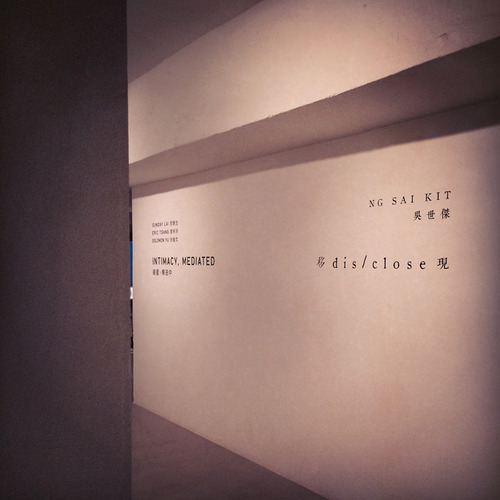
© Installation view 'dis/close’ at Osage Gallery, Hong Kong by Ng Sai Kit
In this sense, Ng Sai Kit does not try to please the human eye imitating reality, or trying to represent possible impressions; he strives to build a new reality, that must feel true in all respects. Rather than describe faithfully the surrounding world, he breaks down - with a 'cubist’ attitude - the reality in levels, shapes, spots and synthesizes in a single series different points of view, which in reality could not be adopted simultaneously. Of this principle of attention we can find numerous references in his earlier works, and particularly in the Meta Landscape series where he seems to experience a deconstructive strategy.
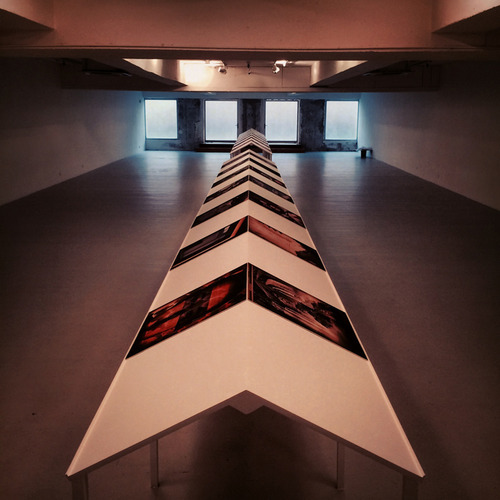
© Installation view 'dis/close’ at Osage Gallery, Hong Kong by Ng Sai Kit
Of this lack of interest in the realistic rendering of the landscape and hence of human figures, we find an almost final statement in the most recent series based on Instagram solutions. This particular technique led him to obtain images of an apparent incomprehensibility, as they are completely different from what our experience is accustomed to when seeing things.
The landscape is split in a multiplicity of points of view to get an almost “total” view of the landscape. In the transition from the vertical grey sections of Meta Landscape to the explosion in multiple colored faces of Instagrams [Sai Kit has no work titled “Instagrams”. Should it be “the Instagram pictures” ? Or “The Faces of the Other” ?] we recognize the gradual breakdown of the uniqueness point of view, and in fact the introduction into the photographic representation of the element time. The frequent presence of diorama - whether as vernacular fragments of nature or of human bodies - demonstrates even more a need to perceive different moments of the same scene. Ng Sai Kit suggests that reality cannot be read and understood at a glance instant. It must be perceived with a precise time of reading, which allows to analyze the individual parts, and re-build them mentally, to come gradually from the image to its meaning.
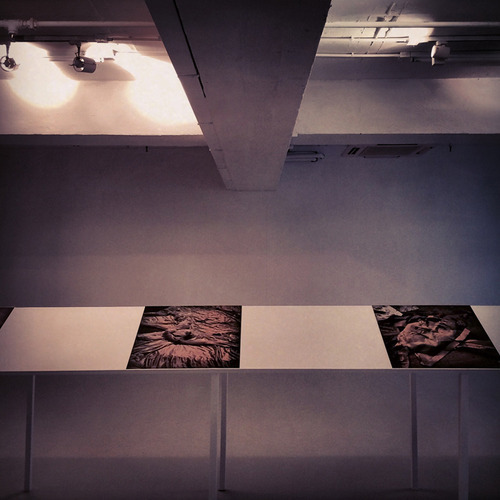
© Installation view 'dis/close’ at Osage Gallery, Hong Kong by Ng Sai Kit
The simultaneous viewing of different points of view of figure applies in particular to the series Faces of the Other that deliberately deceives the observer. In the reproduction of Botticelli’s Venus - crumpled in the ground - I see the female faceted appearance of Picasso's Femme nue dans un fauteuil but above all the inexorable decay of the image itself.
Almost as in Mimmo Rotella’s torn iconic posters, Ng Sai Kit’s faces establish an ambivalent relationship with reality. Photography goes beyond the reality, but cannot ignore it. The artist works a renewal movement tended to get out of the picture, to get hold of a new physical size of the existing.

© Catalog 'dis/close’ of Ng Sai Kit by Osage Gallery, Hong Kong, 2014
I hear therefore an echo of the critic Pierre Restany. The tearing anonymous, the sudden outbreak of a face, the appearance of a body, take on unexpected importance since they are equipped with a demystifying overexposure. The images have become more real than the myth that they claim to embody, more real than the reality they represent. A doubt may cross our mind when we look at Ng Sai Kit’s photograph depicting a picture of Jimi Hendrix printed on someone’s tshirt.
The work of Ng Sai Kit, and its orientation to new perceptual approaches to reality, follows in the footsteps of the new conceptual realism, and in the wake of those artists that in the context of 20th-century consumer society and industrial expansion sought to reaffirm a humanistic ideal. The more we observe the same thing, the more we empty it of meaning, and this is why the artist must act in the opposite way, uploading new meanings to reality in a final attempt to come to a new awareness.

© Catalog 'dis/close’ of Ng Sai Kit by Osage Gallery, Hong Kong, 2014
It should also be noticed in this body of work a significant experimental aftertaste, that is expressed by a tendency to abstraction, into something purely mental, without any relationship with the concreteness of reality. Furthermore, I see Ng Sai Kit’s interest for a sculptural translation of objects. The artist seems to seek the essential aspect of the objects beyond the outward appearance, made of colors and volumes, which may change over time. There is confidence and creativity in the images created by the Hong Kong-based photographer, yet I see also the ability to cut out significant moments from reality, as well as a desire to translate the pictures into pieces of simplicity that joined together may constitute a new poetics of being in a place.
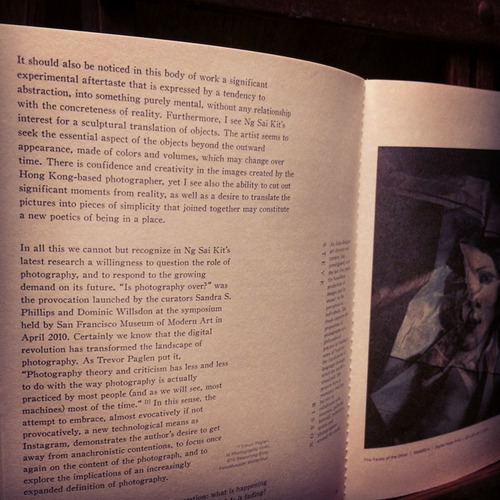
© Catalog 'dis/close’ of Ng Sai Kit by Osage Gallery, Hong Kong, 2014
In all this we can not but recognize in Ng Sai Kits’ latest research a willingness to question the role of photography, and to respond to the growing demand on its future. “Is photography over?” was the provocation launched by the curators Sandra S. Phillips and Dominic Willsdon at the symposium held by San Francisco Museum of Modern Art in April 2010. Certainly we know that the digital revolution has transformed the landscape of photography. As Trevor Paglen put it «Photography theory and criticism has less and less to do with the way photography is actually practiced by most people (and as we will see, most machines) most of the time».[Trevor Paglen 'Is Photography Over?, Still Searching Blog, FotoMuseum Winterthur] In this sense, the attempt to embrace, almost evocatively if not provocatively, a new technological means as Instagram, demonstrates the author’s desire to get away from anachronistic contentions, to focus once again on the content of the photograph, and to explore the implications of an increasingly expanded definition of photography.
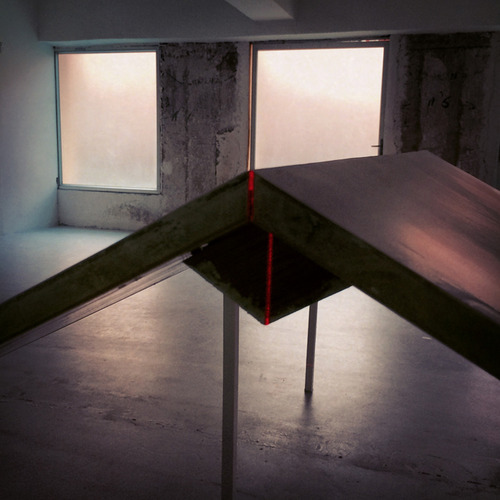
© Installation view 'dis/close’ at Osage Gallery, Hong Kong by Ng Sai Kit
We are left with a question: what is happening to the landscape of Ng Sai Kit? Is it fading? Was the philosopher Jean Baudrillard right when he wrote that «Every photographed object is merely the trace left behind by the disappearance of all the rest»? [“Jean Baudrillard: Art and Artefact”, edited by Nicholas Zurbrugg, Sage Pubblications Ltd, 1997]
…
::dis/close: A Solo Exhibition by Ng Sai Kit
Osage Gallery, Hong Kong
05.09.2014 - 30.09.2014
Curated by Chloe Chu, Yohsuke Ishizuka
If Instagram killed photography, what is Ng Sai Kit doing on it? For the last two years, the established Hong Kong photographer has been an active Instagrammer. Rather than your usual selfies, food-porn, and travel diary however, Ng’s Instagrams of abject spaces and imageries probe the found physical and cultural frames that are enclosed within his own. Through Ng’s series of Instagram works, dis/close aims to investigate how social dynamics are embedded within our information networks, and technological hardware, determining what and how we see, as well as the frictions and synergies between social media platforms and photographic languages.
---
LINKS
Ng Sai Kit
Osage Gallery
China
share this page